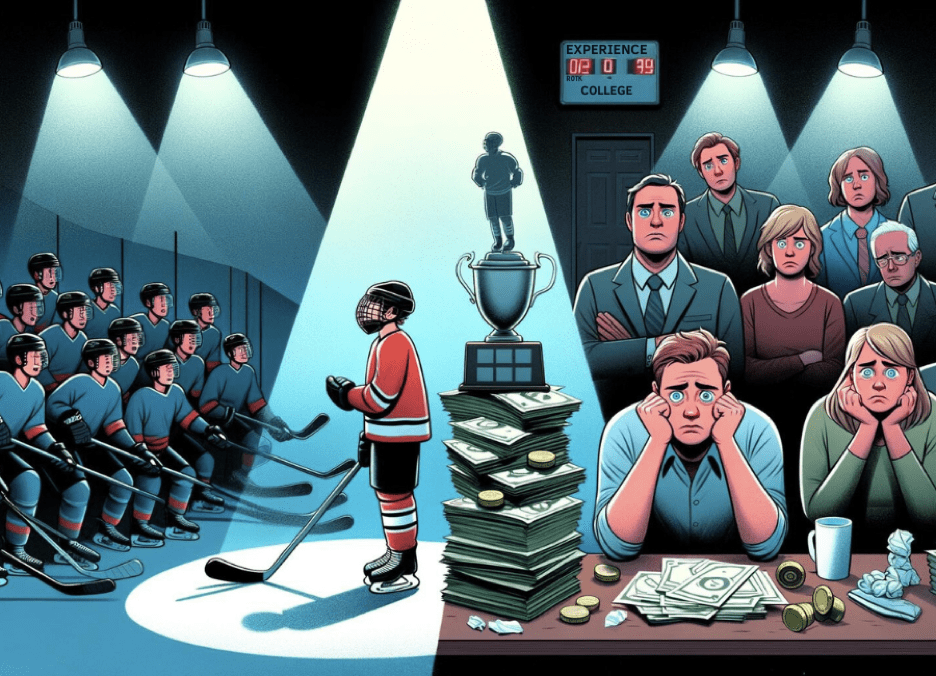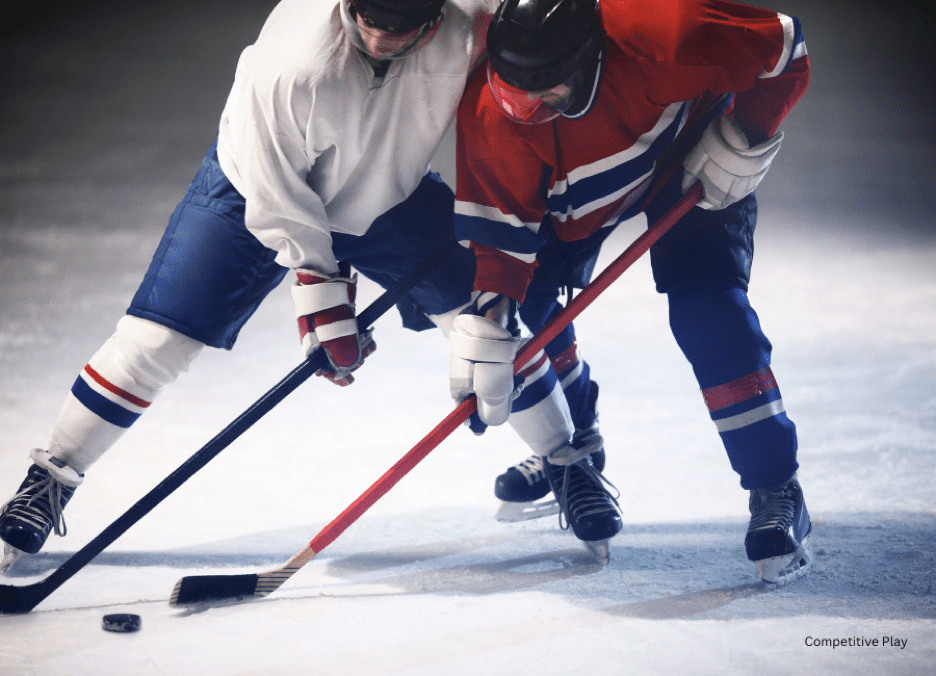As hockey parents, we’re no strangers to the dreams our kids have of making it big on the ice. From the early mornings at the rink to the countless miles traveled for tournaments, we’re there every step of the way. Over the years, we have seen our children’s eyes light up at the sight of freshly zambonied ice, and they cannot wait till it is parked to hit the shiny ice! We have shared in the thrill of their victories and provided comfort during the tough losses. But as our young athletes grow and the competition heats up, we’re faced with a crucial decision: Is Tier 3 Junior Hockey worth it?
The Dream vs. The Reality

Tier 3 Junior Hockey is often seen as a golden opportunity. It offers more exposure, more ice time, and the potential for the athlete to play at higher levels, including Division 3 college hockey.
The promise of scouts and coaches noticing our child’s talent can be incredibly enticing. Who wouldn’t want their child to have the chance to shine and potentially carve out a future in the sport they love?
Yet, like every major decision, it’s important to weigh the benefits against the costs – both financial and personal. Let’s take a closer look at what this path entails.
The Dream
The dream of Tier 3 Junior Hockey is built on the allure of greater exposure and opportunity.
It’s about getting noticed, standing out, and perhaps even catching the eye of college scouts who can offer a spot on a Division 3 team. For many young players, this level of hockey represents a significant step up, offering them the chance to compete at a higher intensity, against stronger opponents, and under the watchful eyes of those who could influence their future in the sport.
Parents and players alike often see this as a stepping stone to bigger things.
The idea is that playing Tier 3 hockey can lead to better opportunities down the line, whether that’s in college hockey or even beyond. The dream is powerful and compelling, driving families to make considerable sacrifices in pursuit of that next big break.
One of the most significant benefits of Tier 3 Junior Hockey is the extensive ice time it provides. This increased ice time is critical for young players who are serious about advancing their skills and taking their game to the next level. Here’s how it plays out:
In Tier 3 Junior Hockey, the practice schedules are typically more rigorous and frequent than those in lower tiers or high school hockey.
Players often find themselves on the ice multiple times a week, engaging in high-intensity drills, skill-building exercises, and game strategy sessions.
This consistent and focused practice time allows players to refine their techniques, improve their physical conditioning, and have a deeper understanding of the game. But this is a general rule, some practice less, ask questions. We will repeat this over and over!
The Reality
However, the reality of Tier 3 Junior Hockey can be quite different from the dream. While the increased exposure and competition are undeniable benefits, they come with significant costs. Financially, Tier 3 hockey can be a substantial burden. The fees for participation, travel expenses, and the ongoing need for high-quality equipment can quickly add up.

For many families, this means making tough choices and sacrifices, sometimes even putting a strain on household finances. Some organizations will include tuition, transportation, uniforms, meals on the road, and even living expenses – some just tuition and you cover the rest. Find out all the nitty gritty, before the kid hits the road or makes a decision.
Are there other priorities or needs that might be impacted by the investment in Tier 3 hockey?
Beyond the financial aspects, there are personal costs to consider as well. The demanding schedule can take a toll on the whole family, with weekends dominated by games and tournaments, and weekdays filled with practices and training sessions.
This commitment can impact not just the player, but the entire family’s routine and lifestyle. We all know Ice Hockey can be all-consuming, this is no different. If they are abroad, parents or the family will wish to travel at some point to see the athlete!
It’s important to recognize that the pathway from Tier 3 to Division 3 college hockey is not as straightforward as it might seem. The competition is fierce, and a small percentage of players make the leap to the next level.
Even then, scholarships are rare, meaning that families often continue to bear significant expenses even if their child makes it to a college team. This reality check can be sobering for many parents and players who might have hoped for a smoother, more financially supportive journey.
Tier 3 Junior Hockey offers tantalizing possibilities, it’s crucial to approach this decision with a clear understanding of both the dream and the reality.
Balancing the potential rewards with the inevitable costs can help families make informed choices that are best for their young athletes and their overall well-being.
Stay tuned as we delve deeper into the specific pros and cons, share real-life stories, and provide guidance to help navigate this important crossroads in your child’s hockey journey.
More Time on the Ice: A Crucial Advantage with Tier 3 Junior Hockey
Intensive Practice Schedules
All leagues should provide the basics below, some may be included with tuition, and some more practice, exposure, and mentorship than others. Again, ask questions!
Competitive Games
Tier 3 Junior Hockey teams play a substantial number of games throughout the season. This high volume of competitive play exposes players to various game situations, from power plays to penalty kills and everything in between. The experience gained from these games is invaluable, as it helps players learn to perform under pressure, make quick decisions, and adapt to the fast-paced nature of high-level hockey.

Specialized Coaching
Another key aspect of Tier 3 Junior Hockey is access to specialized coaching. Coaches at this level are often more experienced and have a deeper understanding of advanced hockey concepts.
They can provide tailored feedback, correction, and guidance, helping players to address specific weaknesses and enhance their strengths. This level of personalized coaching is crucial for players aiming to compete at the collegiate level.
Development Camps and Tournaments
Many Tier 3 programs also offer opportunities to participate in development camps and high-profile tournaments.
These events provide additional ice time and expose players to a wider range of competition. They are also excellent platforms for players to showcase their skills to scouts and college coaches.
Building Physical and Mental Resilience
The demanding schedule of Tier 3 Junior Hockey also helps players build physical and mental resilience. The rigorous training and frequent games require a high level of physical fitness and stamina. Moreover, players learn to cope with the mental challenges of intense competition, such as dealing with pressure, overcoming setbacks, and maintaining focus.
Making an Informed Decision
Ultimately, the decision to pursue Tier 3 Junior Hockey should be made with a full understanding of both the potential benefits and the significant costs. It’s about finding a balance that works for your family and supports your child’s dreams while maintaining overall well-being and financial health.
Delaying College for Tier 3 Hockey: A Worthwhile Investment?
One of the key considerations for families is the potential delay in attending college if a player pursues Tier 3 Junior Hockey. Many players spend an extra year or two in junior hockey leagues before transitioning to collegiate play. This delay can be beneficial in terms of skill development and maturity, allowing players to enter college hockey more prepared and competitive.
However, this path also means postponing academic and career advancements. Parents must consider whether the additional time spent in juniors is worth the potential benefits. The financial costs continue during this period, and there’s always the risk that the hoped-for college opportunities may not materialize as expected.
Choosing Club Hockey: An Alternative Path
Given these considerations, some players and families opt to go directly to college and play club hockey instead of pursuing Tier 3 Junior Hockey. Club hockey offers a competitive environment with significantly lower financial and personal costs. Here’s why some choose this route:
Cost-Effective
Club hockey is generally more affordable than Tier 3 Junior Hockey. The costs associated with club hockey are typically limited to equipment, travel, and minor team fees. This option alleviates the financial burden on families, allowing them to allocate resources to other essential areas such as education.
Balanced Lifestyle

Playing club hockey allows students to focus on their academics while still enjoying the sport they love. The commitment required for club hockey is less intense than that for Tier 3, providing a more balanced lifestyle. Students can engage in other college activities, internships, and academic pursuits without the demanding schedule of junior hockey.
Continued Competitive Play
Club hockey is still competitive and provides a platform for players to continue improving their skills. Many colleges have well-organized club hockey programs that compete at a high level. While it may not offer the same exposure as Tier 3, it still allows players to enjoy the game and stay active in the sport.
Less Pressure
The pressure and intensity associated with Tier 3 Junior Hockey can be overwhelming for some players. Club hockey offers a more relaxed environment where players can enjoy the game without the high stakes and stress of pursuing a professional or collegiate hockey career.
Making an Informed Decision
Ultimately, the decision to pursue Tier 3 Junior Hockey or go directly to college and play club hockey depends on individual circumstances, goals, and family dynamics. It’s essential to weigh the potential benefits against the financial, personal, and academic costs. Open communication and realistic expectations are key to making the best choice for your young athlete’s future.
Join the Conversation!
As we continue to explore the pros and cons of Tier 3 Junior Hockey, we’ll be sharing real-life stories from families who have faced this decision, providing insights and advice from experts, and offering guidance to help you navigate this important crossroads in your child’s hockey journey.
Stay tuned for more detailed discussions, and let’s keep the conversation going. Share your experiences, ask questions, and connect with other hockey parents! Together, we can support each other in making the best decisions for our budding hockey stars.



